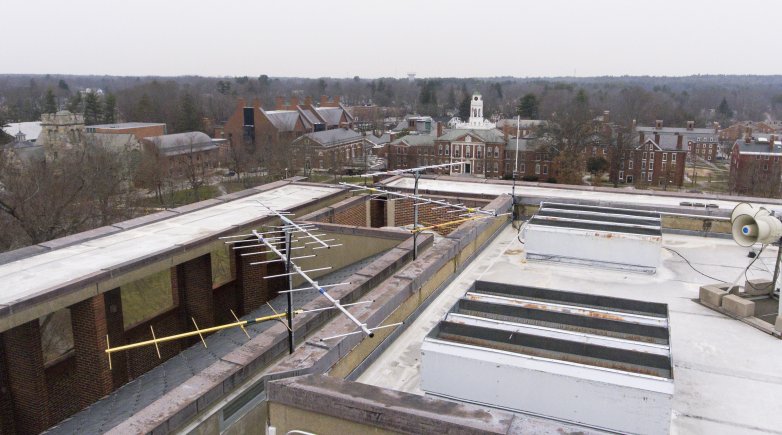Flight school: Exeter to track bird migration
A new receiving station on the library roof will collect data from hundreds of winged species.
Eight antennae can detect movement of tagged birds, bats and butterflies from a distance of up to 30 kilometers.
If a certain Hudsonian godwit, a handful of red-necked phalaropes or any one of 300 ruddy turnstones happen past Exeter this spring, Chris Matlack will know it.
The instructor in biology, ecology and ornithology has partnered with Motus, a Canada-based wildlife tracking network, to collect migration data for hundreds of species of tagged birds, bats and butterflies.
Motus representatives were in Exeter last week to install a data receiving station with eight antennae atop the Class of 1945 Library. Now, if any of the 25,284 tagged animals wing within 30 kilometers of the library roof, the receivers should be able to detect and record the movement.
Matlack heard about the Motus network from Jody Kashden ’80. Kashden had been part of an alumni birding foray to Costa Rica that Matlack had led. During a campus visit to see her son, Orion Bloomfield ’20, she sought out Matlack to tell him about the network.
Matlack attended a presentation on the Motus network at Seacoast Science Center and applied for funding through the Aileen and John Hessel, Class of 1952, Innovation Fund.
“Any bird, bat or butterfly that has been trapped and fixed with a nanotag will ping our antenna,” Matlack said. “We will have access to some data sets and hopefully will be able to have our students involved in their analysis.” Matlack hopes also to involve his students in tagging monarch butterflies when they stop over in the Academy fields.
The nanotags range in size from 0.2 grams for butterflies to 2.6 grams for larger bird species and have lifespans that vary from 20 days to forever, depending on the model.
Exeter’s station is one of only a few in New Hampshire but is among 995 in 31 countries around the world.
“There is now a push to have antennas across New Hampshire and Vermont so that we plug any gaps in the Eastern network,” Matlack said. “Our station’s reach will extend east to the ocean and west towards Manchester, where there will be another receiver installed soon.”



